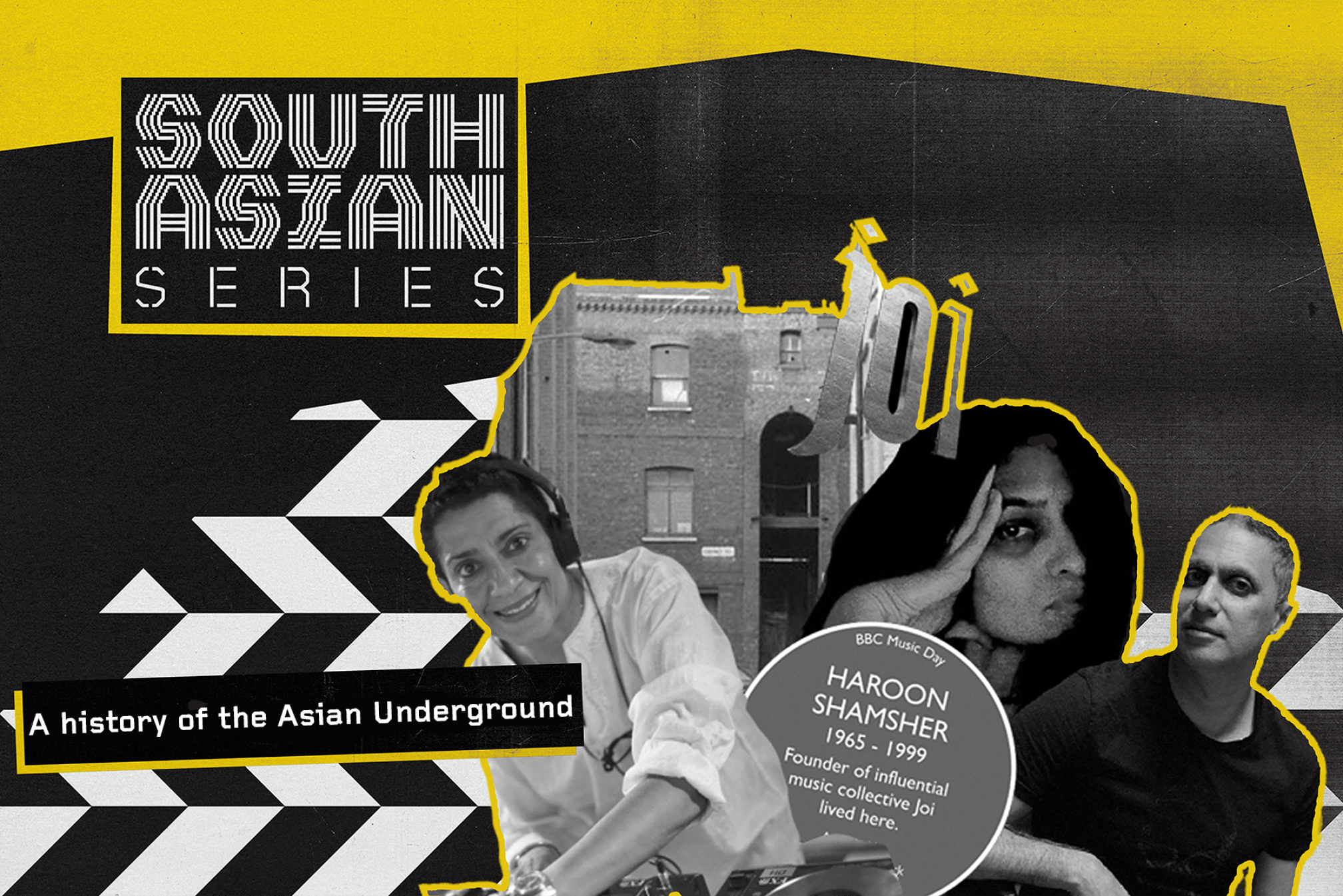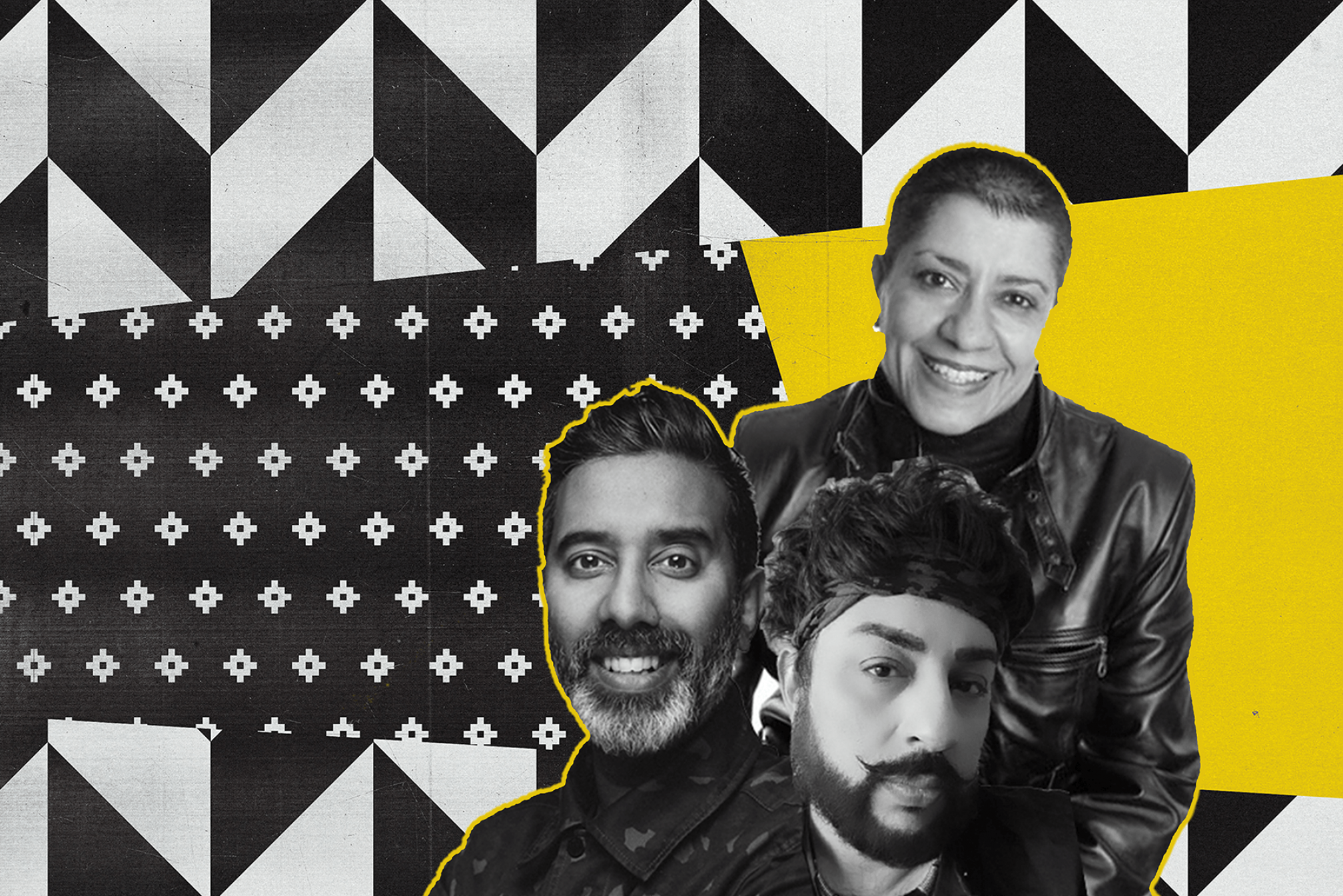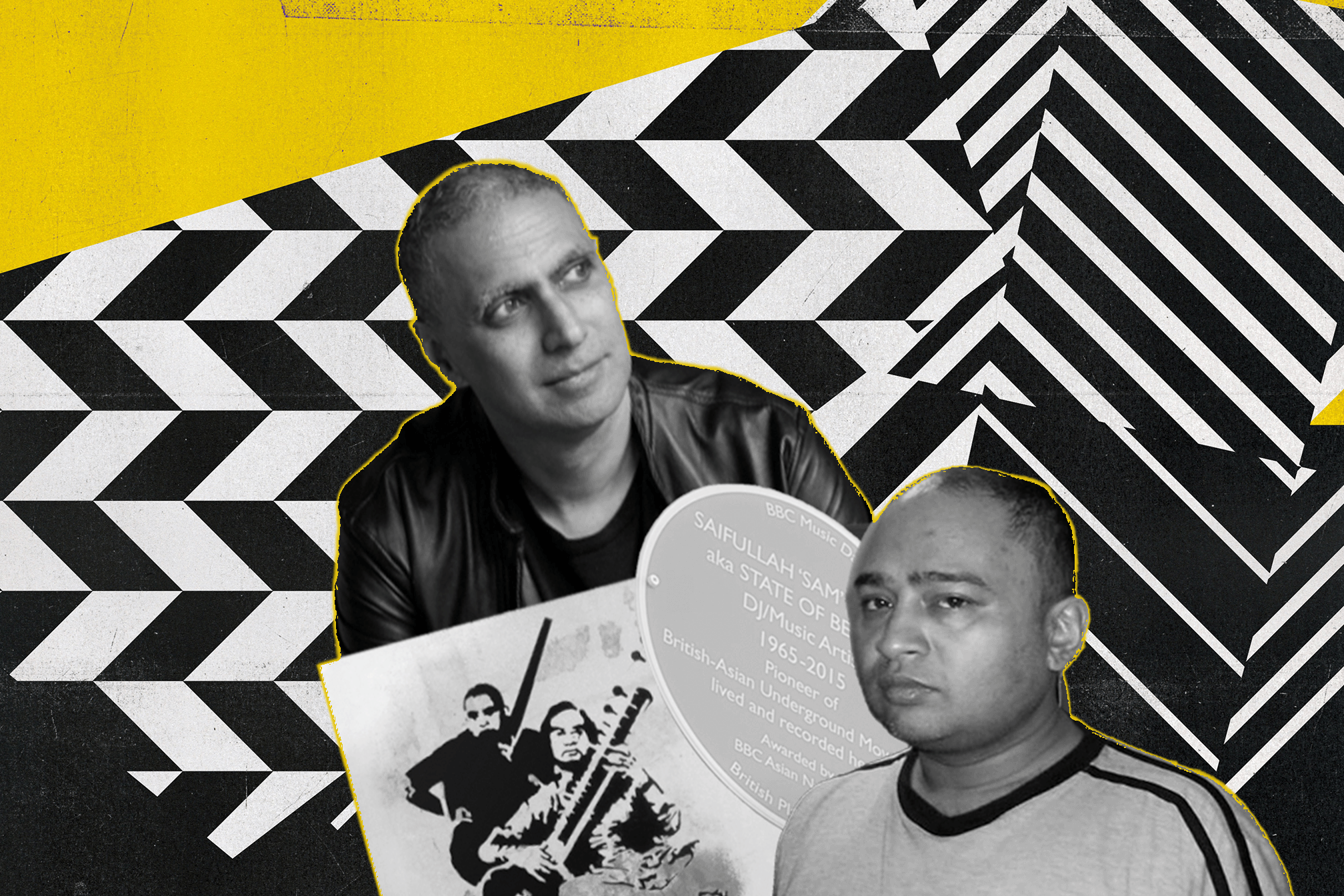 Features
Features
A potted history of the 1990s British (South) Asian Underground
Tara Joshi traces the '90s lineage of the Asian Underground movement, speaking to key figures DJ Ritu, Sweety Kapoor and Nitin Sawhney
“I had never seen so many Bangladeshi kids in a dance venue,” says DJ Ritu over the phone. She’s reminiscing fondly of the 1990s, specifically, Hoxton, East London at a venue called Bass Clef. The venue held the infamous Asian Vibes night, run by Farook and Haroon Shamsher, two British Bangladeshi brothers. The smell of incense wafted through the air and their mum’s saris were pinned to the wall. Asian Vibes at Bass Clef played a fusion of breakbeats and South Asian sounds to rapturous crowds with the Shamsher brothers – known as the band and soundsystem Joi – at the helm.
“There was always a lot of energy in the place,” Ritu, a key figure at the time, says. “[The brothers would] be doing some mad stuff on the decks, they were a pair of characters. As far as I know, that was the first regular Asian Underground night.”
Bass Clef was pivotal at a time when British South Asian culture was finally gaining recognition as the ‘Asian Underground’. Rooted in British club culture, South Asian artists in the 90s made music that pulled as much from jungle, dub and trip-hop as it did from the intricacies of Indian Classical. The Asian Underground was a necessary change for South Asians to start taking control of their own spaces in the industry beyond Bhangra.
Read this next: Welcome to Mixmag's South Asian Series
UK Bhangra had been healthy and thriving since the 1970s, combining the melodic, often euphoric Panjabi folk music with western instrumentation and technology – by the early 90s, the likes of Bally Sagoo and Panjabi MC were at the forefront, marrying Bhangra with dub, reggae and hip hop production (Bally was also known for his Bollywood remixes). Although back in the 1960s Ravi Shankar had broken through to the West from India, and fusion act Monsoon had played on Top of the Pops in 1982, overall, in the last decades of the 20th century the assumption had been that if you were brown, you were making Bhangra – or that you were simply not marketable.
“For British Asians making music back then, you could approach mainstream major labels like Sony or Warners or whoever, and you’d probably be rejected, because they didn’t know what to do with you,” explains Ritu. “Or you could go to a Bhangra label. But what if you were a British Asian artist who didn’t want to make Bhangra?”
Ritu is a promoter, DJ and radio host, and in the 90s she also performed as part of the band Sister India as well as A&Ring for Outcaste Records, founded back in 1994 with Paul Franklyn and Shabir "Shabs" Jobanputra (who would go onto create UK behemoth Relentless Records, which has been home to Artful Dodger, Jay Sean and, more recently, Bad Boy Chiller Crew). Outcaste was one of several labels – and then club nights – formed around that era, providing space for those British South Asian artists who, like Joi, were doing something a bit different. Aki Nawaz and Kath Canoville arguably led the way back in 1988 when they founded the seminal Nation Records, after major labels turned down their fusion album, 'Fuse'.
The 1980s and 90s were an especially exciting and interesting time for the Bhangra scene – terminology like ‘Asian Kool’ was used to describe what was happening (the ‘k’, Ritu explains, a reference to the five Ks of Sikhism), and interrogation was starting to happen about the political reasons for which Blackness had been commodified as cool in a way that Asianness hadn’t been (as the 1996 book Dis-orienting Rhythms: The politics of the new Asian Dance Music by Sanjay Sharma, John Hutnyk and Ashwani Sharma examines). Traditional sounds were melding with Black music, there was the burgeoning secret thrill of daytime raves – South Asian parties that facilitated the specific needs of this community of youths with typically strict parents and strict curfews. By 1993, it was a common sight to see young British South Asians trailing around the corner of London’s Wardour Street every Tuesday evening, trying to get into the now legendary, sweaty Bombay Jungle nights at the Wag Club.
But Bombay Jungle wasn’t just about Bhangra. After experiencing the consistent racism of being rejected for entry from various nights in central London, Mits Sahni (who was also a member of Hustlers HC, a socially conscious rap group signed to Nation) set up Bombay Jungle as a safe haven of sorts. One floor was dedicated to the Panjabi import, while the other was largely home to Black music genres like hip hop, ragga, reggae and swing (effectively present day R&B). The aforementioned Asian Underground frontrunner night Asian Vibes at Bass Clef – which would later become Blue Note – was happening around the same time in Hoxton.

Sweety Kapoor is another instrumental figure from the time. She works today as a curator, creative producer, radio host and runs a night called Brown Girl in the Ring. Back in the 90s she ran a night called Anokha alongside two other key players: the formidable, Mercury Prize-winning tabla player Talvin Singh, and DJ and producer Sam Zaman aka State of Bengal. Zaman was hailed as the Godfather of Asian Breakbeat, starting out with the Shamsher brothers as part of the Joi Bangla Soundsystem before venturing solo, as well as mentoring his younger brother Deeder, who would become a rapper for Asian Dub Foundation.
Anokha was one of the movement’s most important club nights, taking place at the Blue Note on a Monday. Sweety explains that, as a descriptor for what they were all doing, ‘Asian Underground’ is not the most comfortable label: “The irony of it was that we kept saying at the time that we cannot give you a term to define this. I remember saying it time and time again to journalists: yes, these artists and bands all had something in common, but actually musically they were so varied! So how do you term that?” Ritu echoes Kapoor, stating, “This was the voice of the second generation making their mark [and] the music was fascinating. But it was a very loosely cut ‘collective’.”
It was the title of Talvin’s 1997 compilation, 'Anokha: Soundz of the Asian Underground', that would provide the umbrella term of sorts for those South Asian-origin artists in the UK making music across the spectrum. Generally the term found artists and bands innovatively blending elements of Indian Classical with everything from soul, jazz and hip hop (as in the case of Nitin Sawhney) to contemporary club sounds like drum 'n' bass (as per Talvin), but even rock (Cornershop), punk (Fun-Da-Mental), breakbeat (Joi), trip-hop (Sister India), dub (Asian Dub Foundation), reggae (Apache Indian) and jungle (UK Apache). By the late 1990s, fusion artists from South Asia were able to break into the European market too – North India’s Ananda Shankar who, back in the 1960s had played with the likes of Jimi Hendrix in LA, went on tour with State of Bengal, culminating in the pair putting out an album called 'Walking On' in 1999.
Read this next: How Asian Dub Foundation's stand against racism connected generations of British Asians
Where Bhangra nights were predominantly attended by young South Asian people, Asian Underground attracted a more mixed crowd across ages and ethnicities. “Nights like Outcaste and Anokha were much tamer than the Bhangra parties,” adds Ritu, “It was slightly spiritual and more chilled.”
Sweety remembers a night where Lee “Scratch” Perry attended Anokha and asked to go on the mic, with State of Bengal on the decks. “[Lee] understood what was happening at Anokha,” she says, “He connected with the cultural and political significance of it, he felt the synergy with what we were doing. It didn’t need to be explained, he just understood.”
The likes of Björk and Goldie were also regularly at Asian Underground nights – Björk not only worked with Talvin Singh on several tracks and live shows, but she discovered State of Bengal at Anokha, leading to him signing to her label, remixing her tracks and opening for her on her world tour. Meanwhile Goldie and co’s drum 'n' bass Metalheadz Sunday Sessions nights were at Blue Note, so the crowd was not dissimilar to that of Anokha.
For Nitin Sawhney, the prolific musician, composer and producer, it was a surreal time hearing his music on the radio, and going to clubs where he could see that Asians were seen as cool. “I grew up in a very white area with [far-right group] the National Front on my doorstep, so you were constantly attacked on the basis of having brown skin,” Nitin says, “So suddenly to be in a situation where a lot of white people as well as Asians and Black people were coming to these club nights, it felt like, bloody hell, this is incredible. They’re listening to sitars, to Indian Classical singers, to bansuri [Indian flute] and they’re jumping up and down to it. Those nights felt full of optimism, it felt like we were changing things – something was shifting and people were finally getting it and understanding multiculturalism. It felt like anything was possible. ”
“I was working 24/7 running Anokha,” Kapoor states, “people have expressed when they walked into Anokha they would be hit with a feeling something very special was happening. There was a buzz, an energy shift – people didn’t just come there for music, they came to connect, meet like-minded people, it was a birthplace for creativity, ideas and collaborations. People found a home that hadn’t existed before, and not just for the Brown kids. All these spaces were multicultural Britain in motion.” She adds that this included people from the South Asian Caribbean community, who had rarely felt accepted in more traditional South Asian diasporic spaces.
“Everything felt fresh, everything felt new,” agrees Ritu, “There was funding around these things. Everything felt like it could be something and it could lead to something.”
“Look at people like Black Star Liner,” Nitin says, “He was programming in a way that was so interesting and new. And it was the same with so many people at that time – if you drop a lot of that music in a club anywhere now, it still goes down a storm.”

Culturally specific magazines like 2nd Generation were charting what was going on, but so were the biggest fashion and culture magazines: Nitin was on the cover of Dazed and Confused, Talvin was on the cover of DJ Mag, Asian Dub Foundation were on the cover of NME. All three of those acts were nominated for the Mercury Prize, and Talvin won in 1999 for his debut album 'OK' (incidentally, Susheela Raman was also nominated in 2001, though she never saw herself as part of Asian Underground).
In 2002, Bobby Friction and Nihal Arthanayake had an award-winning flagship show on BBC Radio 1 called Asian Beats. British South Asian artists were signing huge deals with major labels. Nitin points to moments like playing with Sting, or Madonna naming 'Beyond Skin' as one of her favourite records in The Face: “This whole progression was happening. It wasn’t just me, it was Asian artists as a whole being accepted into the mainstream. We weren’t just there, we were influencing what was going on.”
But something was shifting. Partly, this was to do with the nature of the music industry, treating South Asian creativity as a trend rather than a movement of people – wary of this, Nitin had always distanced himself from “Asian Underground” as a label. Plus, people were getting older and growing out of clubbing – of course things were moving on. Still, it’s hard to dismiss the rupture posed by September 11, 2001, when a series of coordinated terrorist attacks by the militant Islamist terrorist group al-Qaeda took place in the United States. All three interviewees mention that it was a point after which all Brown people and their spaces were met with a resurgence of fear, suspicion and scepticism from white establishments across industries. Though there was still some scope for artists in the coming years making more mainstream sounds rooted in genres like R&B (such as the Rishi Rich Project and Rouge), over the coming years, many of Asian Underground’s more leftfield artists were dropped from major labels, the media lost interest, and the money was gone.
Read this next: How classic cars and soundsystems connect Southall residents to their Indian roots
It became increasingly rare that artists of South Asian origin were recognised in prestigious industry spaces – and those who did were individuals, rather than being seen as part of some wider scene (though arguably this spoke to the changing nature of British Asian identity and desire for “integration” post-9/11).
“It’s blatant, endemic racism,” says Nitin of how South Asian artists have been treated, “Institutionalised racism is everywhere, and it’s very rife in the music industry. And 9/11 shifted a whole psychology, there was a lot of fear after that and a lot of political opportunism. Racists look for any excuse to justify being racist.”
“After 9/11, there was a sharp change, and we lost some of our coolness because we were viewed with suspicion,” says Ritu, “A lot of the latent racism that had always been there rose to the surface again.”

Of course, even in the 90s, Asian Underground was not some wholly utopian scene. Racism was still rife – Nitin recalls a white journalist writing that he had a chip on his shoulder, while Ritu remembers being turned down for media coverage because the newspapers were covering Talvin Singh winning the Mercury Prize, and “they’re saying you can’t cover a lot of Asians at the same time”.
There was sexism, too. “Women often have to write themselves back into history,” says Ritu, “We’ve been erased from a lot of these narratives, but in the Asian scene, women were often the catalysts and forerunners and enablers. If you look at Nation Records, Kath’s work there was crucial so that the label could function effectively leaving Aki free to concentrate on his group Fun-Da-Mental.”
She also notes a lack of support for women-led projects from within the scene: “I found that once I started my own bands [such as Sister India] the men in the scene that I had helped nurture seemed to slightly go off me, as though they viewed us as a threat. When there’s very limited work and very few opportunities available, people start to climb over each other for small pieces of the pie.”
Read this next: Britain's first out Muslim drag queen: Asifa Lahore is a proud clubland pioneer
Discussing these details can feel tricky when the legacy of Asian Underground as a whole in some ways feels buried, like a cultural erasure. Sweety points to the fact that she had to petition along with family and friends to get the minimal kind of blue plaque recognition for State of Bengal that would be standard for pioneers in any other genre that was so influential in British cultural history (in doing so, they were also able to secure plaques for Haroon Shamsher and Nusrat Fateh Ali Khan). South Asian origin music is rarely played on Radio 1 now, and while the existence of BBC Asian Network is at least something as a space to keep flying the flag, Ritu, Sweety and Nitin all point to the fact that it is “ghettoising”.
Nitin sees a lot of positivity in the current scene when we talk about legacy, sustainability, and the scope to use past learnings. “You have to engage with the politics,” he says, “There’s no other way. Stuff becomes cool and then it goes out of fashion, so you’ve got to be ready with enough determination to do what you want to do, uncompromisingly. People will always try to put you in a box, and the struggle is to climb out of it.”
Sweety notes that culture is constantly evolving to reflect the times we live in, however she says that just because things moved on doesn’t negate how important the Asian Underground movement was: “Punk only lasted, what, a year-and-a-half? And the impact is how big to this day? That’s Asian Underground. In terms of what it did, the influence, the effects felt today? It’s like punk.”
South Asian people have remained a vital, influential part of UK music, regardless of whether the spotlight has been on us. In fact, most of what the Asian Underground stood for feels just as relevant in 2021 as it did nearly 30 years ago. As Sweety says, “It wasn’t just the music, it was across the creative arts, it was political. It was a coming of age, a paradigm shift. This was a group of South Asian kids making noise about our heritage, and we were saying, ‘You don’t get to define us, we’re defining ourselves. You don’t get to write our narratives, because we’re telling you our narratives. We helped to shape this country. We’re British, we’re part of the landscape, the culture, the currency; this is who we are.’”
Tara Joshi is the music editor at gal-dem and a freelance writer, follow her on Twitter


